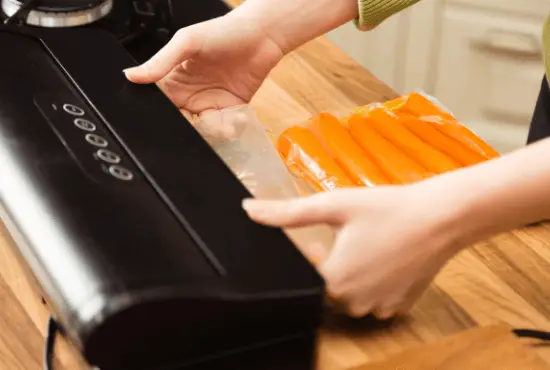In a fast-paced life, everyone searches for a quick and efficient way to keep their food fresh. It is quite possible if you have a vacuum sealer at hand.
If you already own one, you might want to inquire how to freeze food with a vacuum sealer?
You can freeze food with a vacuum sealer by performing some basic steps. For Ziploc bags, ensure to cut off the seal part of the bags and then vacuum- seal. Do not overstuff the bag and allow an inch or two space empty. For mason jars, always pre-freeze the liquid before vacuum sealing it. Also, keep some room for liquid expansion and avoid overfilling the jar.
Different storage containers/bags require a unique approach for vacuum sealing. If you want to know which method will work the best for you, this step-by-step guide is here to answer all your queries.
Table of Contents
Tips for Freezing Food with a Vacuum Sealer
Preserving the freshness of your food can be a hassle. Thanks to the progress in the kitchen tools department, you can now avail plenty of benefits without putting in much effort.
One such brilliant finding is a vacuum sealer machine. It is a must-have in your kitchen drawer and makes food storage and organization much swift.
Vacuum sealing your food before placing it in the freezer can make the whole process effective. As the food has limited to no excess to air, the chances of food spoilage are lower down. Thus, it is a great option and saves your time and money.
How To Vacuum Seal Ziploc Bags?
Most people prefer freezing their food in Ziploc bags. They are convenient, inexpensive, and useful for short-term storage. You can open and close them with ease. However, their seal might not be strong enough to withstand long-term freezing and storage.
Thus, a vacuum sealer comes in handy and provides a sturdier seal that can allow the food to remain stored for an extended time. Secondly, it will remove all the excess air while the food stays fresh and flavorful.
- Firstly, cut the Ziploc seal portion from the bag. The slit should be close to the seal to get a precise and neat cut.
- Fill the bag with the desired food product you want to store and freeze.
- Place the opening part of the Ziploc bag into the sealing strip of the vacuum sealer.
- Now, press the ‘vacuum and seal button. The sealer will come into action and start removing all the excess air out.
- Once it takes out the air, the vacuum sealer will automatically seal the bag and is all set to go into the freezer.
How To Vacuum Seal Mason Jars?
Vacuum sealing a mason jar might sound a bit risky and doubtful. But, not to worry, as you can perform this task with mason jars specifically designed for freezing.
They are straight from top to bottom, without any curve near the neck of the mason jar. It makes them capable of withstanding low temperatures and liquid expansion.
Jars are a great way for storing liquid food in the freezer like soups, milk, smoothies, etc. However, they require additional safe handling so that nothing disastrous happens.
The following tips and tricks will further help you along the process.
- Never fill the jar. Always leave a little space at the top near the lid. It is better to leave at least one inch of space between the liquid and the top.
- Cooldown your food first before pouring it into the jar. Food that is still hot might result in the cracking of the glass if the temperature changes quickly.
- Once you fill out your jar, transfer it to the freezer without covering it with a lid. It is crucial to pre-freeze the content of your mason jar first before proceeding to vacuum seal it.
- This step helps in protecting your food from getting freezer burns.
- When the liquid becomes frozen solid, take the jar back out and vacuum-seal it.
- Now your jar is all ready to be popped inside the freezer.
How To Pre-Freeze The Food Before Vacuum Sealing?
Sometimes, it is better to pre-freeze your food before vacuum sealing and transferring it to the freezer. Some food varieties are very fragile and require pre-freezing first. These include fresh fruits, vegetables, meatballs, etc.
For attaining desired results, spread them out on a baking sheet and pre-freeze them before vacuum sealing. It will prevent the food from getting squished or the freezer burns.
Similarly, saucy food items like pasta, soups require to be frozen until they turn solid. Once they are frozen, vacuum seal your food and shift them inside the freezer. This step works well for all other liquid food as well.
Benefits Of Vacuum Sealing Food
A vacuum food sealer, undoubtedly, is essential for your kitchen. With its assistance, you can enjoy the peak quality of your food and keep the freezer clean and organized.
Good quality and well-reviewed vacuum sealer provides a wide range of benefits like
- It increases the shelf life of food by three to five times.
- It reduces the chances of bacterial contamination.
- Prevent the food from dehydration and freezer burns.
- It allows the food to retain its flavor and juices. Also, keep its nutrient value intact.
- A vacuum sealer also helps in food organization, resulting in more space for storing food effectively.
Frequently Asked Questions
Is vacuum-sealed good for the freezer?
Vacuum sealing protects the food from freezer burns and dehydration over the longer run. Besides, a vacuum-sealed bag/jar keeps your food from contact with air, preventing the moisture from evaporating. As a result, your food remains fresh and flavorful.
Is vacuum sealing the best way to freeze meat?
As meat is protein-based, it is more prone to bacterial contamination. These microbes can be harmful to your health, causing many food-borne illnesses. Thus, vacuum sealing the meat can significantly reduce the chances of bacteria lurking inside, acting as a barrier against it.
What foods should not be vacuum sealed?
Some types of food should not be vacuum sealed at all. They include raw mushrooms, fresh bananas, raw garlic, onion, soft cheese, and freshly cooked vegetables.


